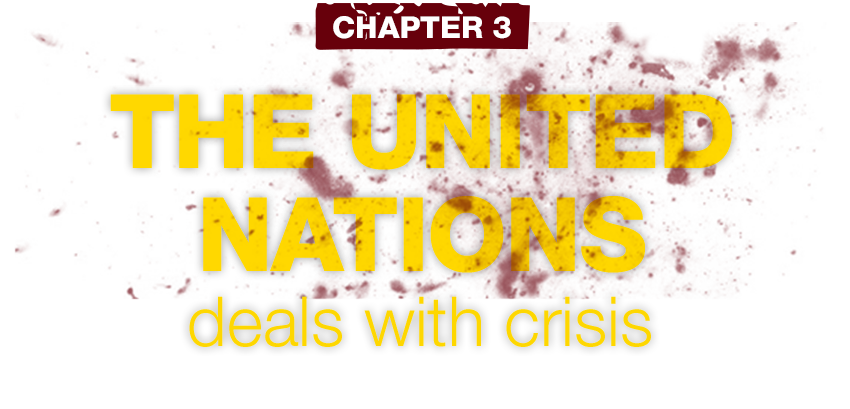The situation in Greater Kasai deteriorated in less than 10 months. Since the first spark in August 2016, it has developed into a major crisis. At least 42 mass graves have been discovered, and further investigations are still needed. More than one million people have been displaced and tens of thousands of refugees have fled to Angola. The mission of the United Nations (UN) in Congo is the most expensive UN Mission in the world: with a budget of over one billion dollars a year, nearly 20,000 employees, and 18 years of presence in the country. So how did the UN react?
The Kamwina Nsapu crisis in Greater Kasai began with the return of Étienne Tshisekedi. The historical opposition leader had been absent from the Democratic Republic of the Congo (DRC) for two years. He returned five months from the end of President Kabila’s second and final mandate, and has an unmatched ability to mobilize crowds. Unrest was expected in Kinshasa, Lubumbashi, Goma, with demonstrations and repression... but at first it was confined to cities. Foreign observers did not imagine having to face a wave of “mystical attacks” or massacres in Greater Kasai as well.
When the Chief Jean-Prince Mpandi was killed on 12 August 2016, it was almost a non-event. No one was focused on Greater Kasai. Yet, there were multiple opposition figures from the area, headed by Étienne Tshisekedi and his son Felix, as well as Samy Badibanga and Bruno Tshibala, who played leading roles in successively becoming the Prime Ministers of Joseph Kabila. In August 2016, the international community had two priorities: political negotiations for an inter-Congolese dialogue and the organization of elections. Kamwina Nsapu was only a customary chief at the time, whom no one had heard of.
The next day, on the 13th of August, the Rwangoma ![]() massacre occurred in eastern Congo. 51 people were killed in a neighborhood just two or three kilometers from the residence of the head of state, Joseph Kabila, who had just left the city after promising peace in Beni. The massacre seems to have been intended as a message. The situation worsened everywhere. After the crises in Rwanda, Burundi and the Central African Republic, the Sudanese crisis overflowed into the Congo, bringing tens of thousands of refugees and combatants with it. The men of Riek Machar
massacre occurred in eastern Congo. 51 people were killed in a neighborhood just two or three kilometers from the residence of the head of state, Joseph Kabila, who had just left the city after promising peace in Beni. The massacre seems to have been intended as a message. The situation worsened everywhere. After the crises in Rwanda, Burundi and the Central African Republic, the Sudanese crisis overflowed into the Congo, bringing tens of thousands of refugees and combatants with it. The men of Riek Machar ![]() entered eastern Congo. The only thing missing was an armed group. The DRC has nine borders, substantial natural wealth, and all the problems it bring. The United Nations needed to be ready on all fronts.
entered eastern Congo. The only thing missing was an armed group. The DRC has nine borders, substantial natural wealth, and all the problems it bring. The United Nations needed to be ready on all fronts.
MONUSCO had left Greater Kasai two years before the beginning of the crisis, following a decision of the Security Council. In March 2013, Goma ![]() fell into the hands of the M23 rebellion - a humiliation for the Mission and the whole UN system. One resolution called for the establishment of an intervention brigade
fell into the hands of the M23 rebellion - a humiliation for the Mission and the whole UN system. One resolution called for the establishment of an intervention brigade ![]() and to refocus UN personnel in the east of the country and in North Katanga. Since the area of Kasaï had been considered to be peaceful, the MONUSCO office in Kananga closed down. What remained of the UN mission was housed in a prefabricated container in the compound of UNICEF. This move was unfortunate, three years away from the end of Joseph Kabila’s second and final term.
and to refocus UN personnel in the east of the country and in North Katanga. Since the area of Kasaï had been considered to be peaceful, the MONUSCO office in Kananga closed down. What remained of the UN mission was housed in a prefabricated container in the compound of UNICEF. This move was unfortunate, three years away from the end of Joseph Kabila’s second and final term.
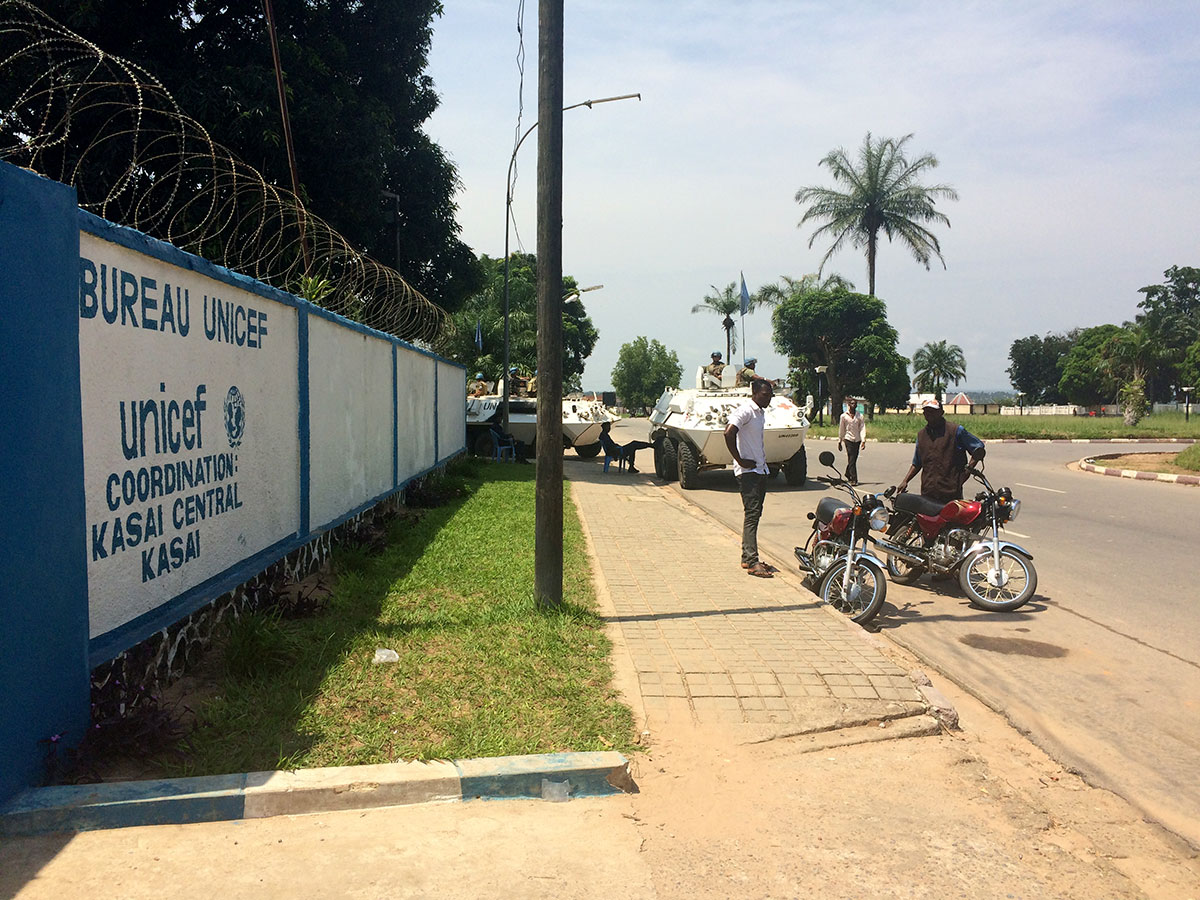
The first MONUSCO cable sent to headquarters after the death of Chief Kamwina Nsapu was dated August 27, 2016. Classified as confidential, it was sent by the Special Representative of the Secretary General of the UN in DRC, Maman Sidikou, and addressed to the head of the Peacekeeping Operations at the time, the Frenchman Hervé Ladsous. In addition, the heads of the key divisions of MONUSCO, the UN Human Rights High Commissioner in Geneva, and the Department of Political Affairs in New York—almost the whole UN system—were put in copy.
"A conflict between a customary chief and state authorities has transformed into a series of violent arson attacks against the police. The authorities have responded by setting up joint police and military operations, resulting in the deaths of many others, allegations of serious human rights violations, and scores of arrests, including children"
Confidential message from the Special Representative of the UN Secretary General in the DRC, Maman Sidikou, to Hervé Ladsous, head of the UN peacekeeping operations in New York on 27 August 2016
Chief Kamwina Nsapu is described as a leader who wants to restore his customary power free from political interference. It would seem that ‘Pandi Ntuma’ ![]() had refused to join the majority and paid the price, by not being recognized by the State. The confidential message speaks of roadblocks, without mentioning negotiations between the customary chief and the Congolese authorities. Fifteen days after the death of the leader, the UN Mission in Congo seems to be unaware that Jean-Prince Mpandi had asked deputies for MONUSCO to intervene, in order to open discussions with the government, and that this request had been refused. For Chief Kamwina Nsapu, it was unconditional surrender or death.
had refused to join the majority and paid the price, by not being recognized by the State. The confidential message speaks of roadblocks, without mentioning negotiations between the customary chief and the Congolese authorities. Fifteen days after the death of the leader, the UN Mission in Congo seems to be unaware that Jean-Prince Mpandi had asked deputies for MONUSCO to intervene, in order to open discussions with the government, and that this request had been refused. For Chief Kamwina Nsapu, it was unconditional surrender or death.
"If I came, where would I be received?" Who is responsible for my protection? So I request that you ask Monusco to ensure my security in Kananga. This should be very simple indeed, because Monusco is a neutral force"
Excerpts from a conversation between Jean-Prince Mpandi and deputies the day before his death, August 11, 2016.
In its cable of August 27, the UN mission does not mention these mediation attempts before the death of the leader Kamwina Nsapu, nor the lifting of some roadblocks as a sign of goodwill. The cable refers to the two attacks by the militiamen of "Pandi Ntumba": one against Ntenda ![]() , another in Tshimbulu
, another in Tshimbulu ![]() against the police, as well as other institutions or houses close to power. This cable describes a raid at the home of Jean-Prince Mpandi
against the police, as well as other institutions or houses close to power. This cable describes a raid at the home of Jean-Prince Mpandi ![]() . It even mentions the suspicious death of Chief Kawuina Nsapu’s predecessor, described as his "father", the arrival of Évariste Boshab, Deputy Prime Minister of the Interior, and a delegation of deputies. One of these, Clément Kanku, called to avoid the use of excessive force
. It even mentions the suspicious death of Chief Kawuina Nsapu’s predecessor, described as his "father", the arrival of Évariste Boshab, Deputy Prime Minister of the Interior, and a delegation of deputies. One of these, Clément Kanku, called to avoid the use of excessive force ![]()
This message ![]() , sent to New York on 27 August, calls into question the official record of the bloody assault on Kamwina Nsapu by the Congolese authorities and gives estimates
, sent to New York on 27 August, calls into question the official record of the bloody assault on Kamwina Nsapu by the Congolese authorities and gives estimates ![]() of about sixty deaths. The message speaks of a stocktaking
of about sixty deaths. The message speaks of a stocktaking ![]() of at least 700 houses burned and 5 Schools destroyed. 40 militiamen were reportedly arrested including 26 minors aged 6 to 17 years. There are also reports of summary executions and arbitrary arrests.
of at least 700 houses burned and 5 Schools destroyed. 40 militiamen were reportedly arrested including 26 minors aged 6 to 17 years. There are also reports of summary executions and arbitrary arrests.
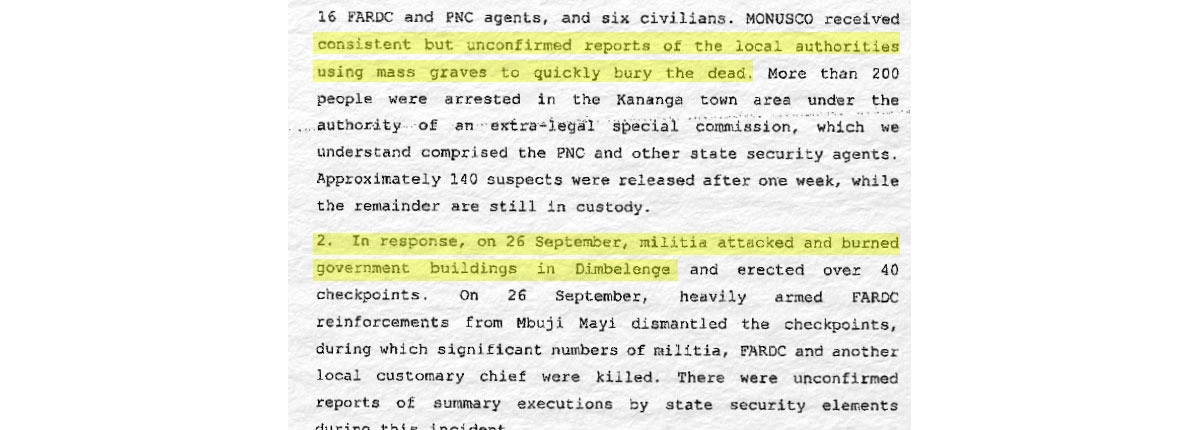
There was a new message on November 2, 2016. This time the text refers to the persistent, but unconfirmed, information about the existence of "mass graves." Local authorities are suspected. According to this cable, the attack on the Kananga airport allegedly led to the death of 50 militiamen, 16 police officers and military elements, and 6 civilians, but during the dismantling operation the security forces reportedly engaged in summary executions. They had come in to reinforce the 21st military region in Mbuji-Mayi. The commander of the operations is called General Eric Ruhorimbere and is today under sanctions of the European Union for generating violence in Greater Kasai. In September, the former members of the 812th regiment ![]() , which later became the 2101st, appeared in Central Kasai.
, which later became the 2101st, appeared in Central Kasai.
In the message of 2 November 2016, MONUSCO said it had strengthened the capacity of the Kananga office by bringing in police officers and conflict resolution specialists. The deployment of UN peacekeepers was not yet discussed, but the Mission concluded its message with a modest call for the deployment of "additional capabilities."
"Deploying additional capabilities is an important first step in an area where the Mission has very limited capabilities"
Confidential message from the Special Representative of the UN Secretary General in the DRC, Maman Sidikou, to Hervé Ladsous, Head of Department of Operations of and of Peacekeeping at the United Nations in New York, 2 November 2016.
The following message was written almost a month later, on November 24th. The UN Joint Human Rights Office (UNJHRO) had completed a "special inquiry" into the violence in Greater Kasai. Between 22 July and 3 October 2016, at least 127 people were executed by the Armed Forces of the Democratic Republic of Congo (AFDRC), including 19 minors and 15 women. The most serious event described in this report took place in Nkoto, in Demba territory. According to UNJHRO, 37 people were executed there on 30 September 2016 and put in at least seven mass graves.
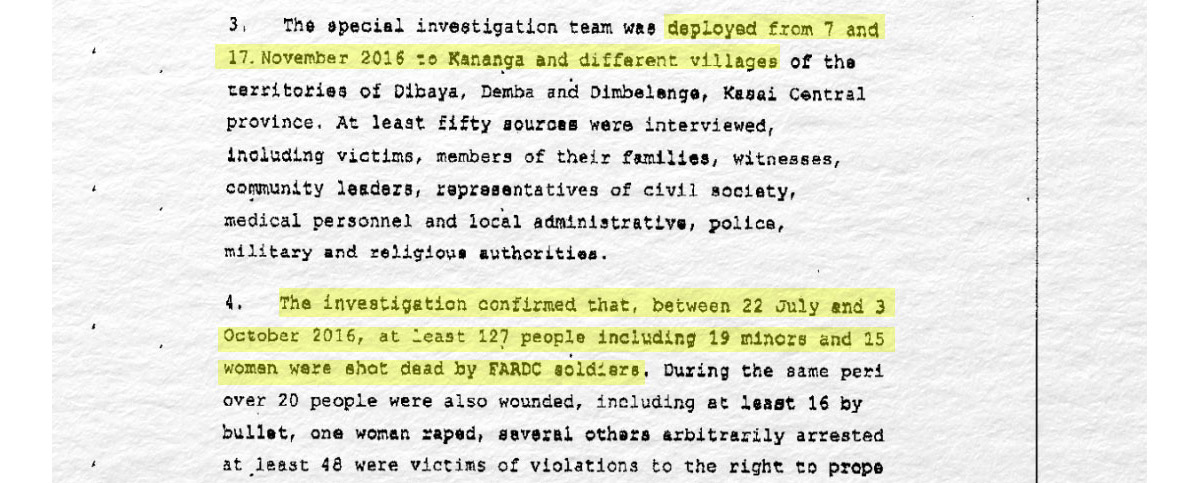
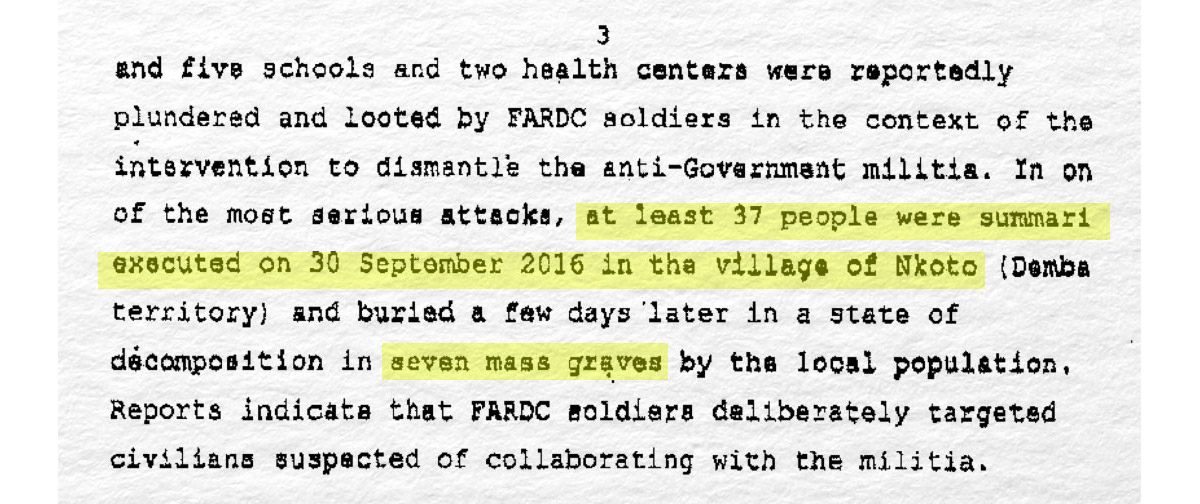
But one more month passed before a hundred peacekeepers were deployed in Kananga in Kasai Central, between 16 and 22 December 2016—one hundred troops for three provinces affected ![]() at the time. If the Security Council officially urged the UN mission to prioritize the use of its capabilities and available resources for the protection of civilians, the prioritization of these crises and the urgency of these situations remained the object of negotiations with the “P5”
at the time. If the Security Council officially urged the UN mission to prioritize the use of its capabilities and available resources for the protection of civilians, the prioritization of these crises and the urgency of these situations remained the object of negotiations with the “P5” ![]() and troop-contributing countries.
and troop-contributing countries.
The tendency in New York was instead to reduce MONUSCO’s workforce ![]() and denigrate the mission, considered to be both very expensive and inefficient. As a result of this negotiating frenzy, as of June 1, 2010, the mission in Greater Kasai had only about 250 peacekeepers, 25 police officers and 60 civilian employees facing a multi-faceted crisis.
and denigrate the mission, considered to be both very expensive and inefficient. As a result of this negotiating frenzy, as of June 1, 2010, the mission in Greater Kasai had only about 250 peacekeepers, 25 police officers and 60 civilian employees facing a multi-faceted crisis.
Since the first warning message in November 2016, the UN mission has maintained a low profile on the issue of mass graves and abuses committed by the army in Kasai. Only the Joint Office ![]() published monthly notes including its latest grim discoveries in Greater Kasaï. In response, the UN mission made little noise. In one of his first statements on Greater Kasai on 12 February 2017, MONUSCO spoke of a crisis marked by "violent atrocities committed by the militiamen" and "regrettable allegations" against the security forces.
published monthly notes including its latest grim discoveries in Greater Kasaï. In response, the UN mission made little noise. In one of his first statements on Greater Kasai on 12 February 2017, MONUSCO spoke of a crisis marked by "violent atrocities committed by the militiamen" and "regrettable allegations" against the security forces.
MONUSCO expressed concern Saturday over the continuing conflict in the Kasai provinces, marked by violent atrocities committed by the Kamwina Nsapu militias.
Press release from MONUSCO, 11 February 2017
Two days later, February 14, 2017, the High Commissioner of Human Rights himself highlighted the violence committed by the army.
"It is time to stop a brutal military reaction that does nothing to address the root causes of the conflict between the government and local militias, but instead targets civilians on the basis of their alleged links with the militias"
Statement of the UN High Commissioner of Human Rights Zeid Ra'ad Al Hussein, February 14, 2017
Massacre at Tshimbulu, February 2017
The "One UN" advocated by the organization has always been a distant concept. Relations between the Department of Peacekeeping Operations, the Department of Political Affairs and the United Nations High Commissioner for Human Rights are often very tense. Established in 1993, the High Commission is one of the newest agencies. And since the 2000s and the mandate of Louise Arbor ![]() , it has sought to have a say in the management of peacekeeping operations, which is not always to the liking of New York. Among its primary tasks are securing punishments against peacekeepers guilty of crimes and preventing war criminals from gaining access to or being supported by peacekeeping operations—as well as bringing these issues into the public eye. The Democratic Republic of the Congo has been an important battleground on all these issues. And the Joint Office, which depends on both - peacekeeping and human rights operations - should have been the child of reconciliation.
, it has sought to have a say in the management of peacekeeping operations, which is not always to the liking of New York. Among its primary tasks are securing punishments against peacekeepers guilty of crimes and preventing war criminals from gaining access to or being supported by peacekeeping operations—as well as bringing these issues into the public eye. The Democratic Republic of the Congo has been an important battleground on all these issues. And the Joint Office, which depends on both - peacekeeping and human rights operations - should have been the child of reconciliation.
"When an allegation is made against a AFDRC soldier, a report from Monusco should be sent to the AFDRC Chief of Staff under confidential cover for appropriate measures"
Extract from the confidential technical arrangement signed between the Government and MONUSCO on 28 January 2017.
At the beginning of 2016, Monusco felt that it was coming back to a better footing in its relations with the government that had earlier grown sour. It could finally announce the resumption of joint operations with the Congolese army after two years of suspension for having protested against the appointment of two "red" generals ![]() on sensitive operations. On January 28, 2016, the government finally agreed to sign a technical arrangement with the UN mission giving Kinshasa full powers in the management of operations and making human rights issues confidential. Officially, this arrangement allowed for the resumption of joint operations between the AFDRC and the UN mission.
on sensitive operations. On January 28, 2016, the government finally agreed to sign a technical arrangement with the UN mission giving Kinshasa full powers in the management of operations and making human rights issues confidential. Officially, this arrangement allowed for the resumption of joint operations between the AFDRC and the UN mission.
This technical arrangement was to be renegotiated, according to UN sources, just before the start of the Kamwina Nsapu crisis. But it reveals the power struggles between the Mission and the Congolese government and an ambiguity in the mission’s mandate. MONUSCO must both protect civilians and support the Congolese government and its security forces. This is what the Security Council reiterates in every new resolution. In 2016, the Council even congratulated the UN mission for signing the technical arrangement with the Congolese government.
“The Security Council ... Underlining the urgent need for the FARDC and MONUSCO to resume joint operations against armed groups, welcomes the commitment of the Government of the Democratic Republic of the Congo and MONUSCO on 28 January 2016 to resume cooperation in order to carry out joint military operations against the FDLR as well as against other armed groups "
Extract from resolution 2277 of 30 March 2016 renewing the mandate of Monusco
The mandate of MONUSCO is the result of a compromise between the members of the Security Council, especially the five permanent members. It is a sort of catch-all that demands everything and its opposite of the UN mission. Thus implementation of this resolution is subject to a lot of interference. Each actor has its own interpretation - members of the Security Council, the UN and all its components (including the Department of Peacekeeping Operations, the Department of Political Affairs), the host country, as well as troop-contributing countries. Officially, MONUSCO is obliged to intervene to protect civilians, but in reality, the sovereignty of the State is paramount. This supremacy of sovereignty has not changed, even after the end of President Joseph Kabila's second and last term. The action of MONUSCO remains largely subject to the will of the Congolese government.
From the first fact-finding mission at the end of September 2016, MONUSCO complained of obstacles and the lack of cooperation between local authorities and security forces. After the start of the insurgency in late November and early December in Tshikapa ![]() , the assessment missions of OCHA and MONUSCO were no longer allowed to investigate more than ten kilometers outside city.
, the assessment missions of OCHA and MONUSCO were no longer allowed to investigate more than ten kilometers outside city.
"Restriction of field trips imposed by local authorities due to precarious security conditions ... within 7 kilometers of the city of Tshikapa"
Extract from the report of the Joint Rapid Assessment Mission of 14 To December 17
"It was impossible to deploy UN personnel beyond the village of Kasala, located around 15km east of Tshikapa, to verify the extent of the violence (...). The governor and the ANR [National Intelligence Agency] lobbied the mission, arguing that it was too risky "
Extract from the report of the fact-finding mission to Tshikapa, 12 and 16 January 2017
The first mission returned from Tshikapa with allegations of "serious abuse" committed primarily by the security forces. More than 70% of respondents mentioned physical and sexual abuse. This mission notes another disturbing fact: that Kamwina Nsapu insurgents massively recruited children. The second mission said it had discovered four new sites that could be mass graves, at the border of the zone prohibited by the Congolese authorities. Discoveries were made near Tshikapa, but no assessment was made on the road leading to Kananga, without protest from the international community. Information "black-outs" grew commonplace.
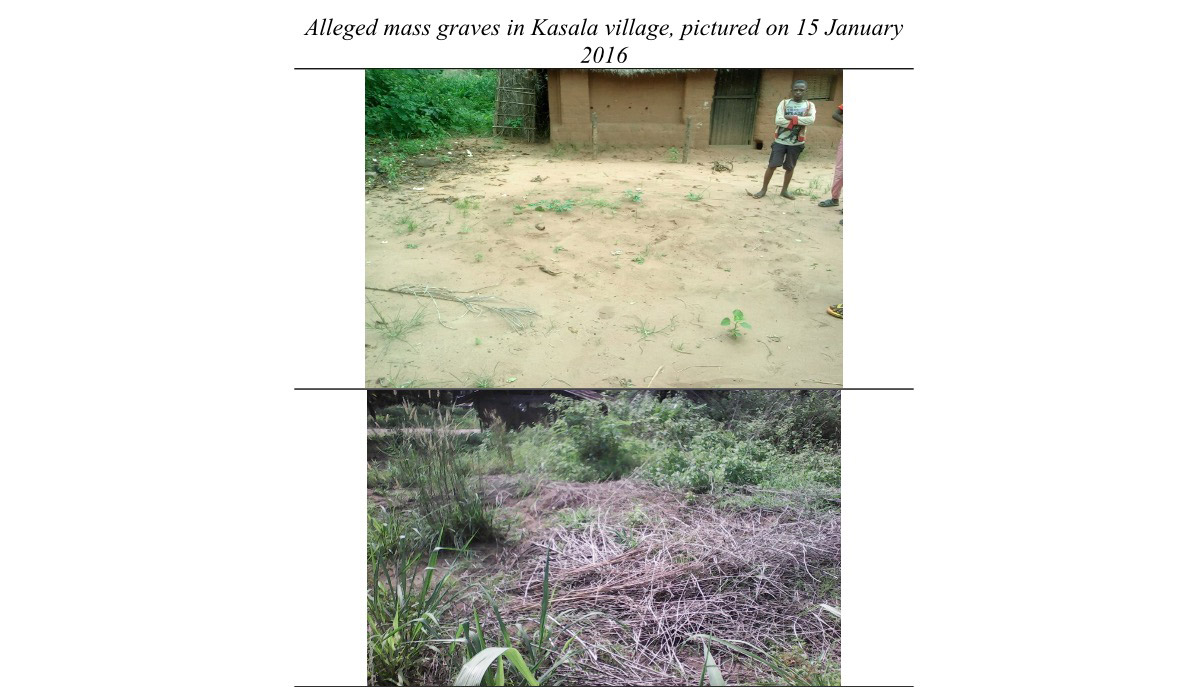
In Greater Kasai, it is clear from confidential UN reports that disproportionate force was used against a popular insurrection which was mostly made up of minors. Kalashnikovs and rocket launchers were pitted against what were, for the most part, wooden toys. In March 2017, on the eve of the renewal of MONUSCO's mandate, relations between the government and the UN mission were tense. At a tribunal of the UN Human Rights Council, on 8 March 2017, High Commissioner Zeid called for the establishment of an international commission of inquiry. Even though the UN said it had documented 42 mass graves so far, its teams continued to be regularly blocked in the field.
"In light of the recurring reports of serious violations and the recent discovery of three new mass graves, I urge the Council to establish a commission of inquiry to examine these allegations,"
Extract from the speech of Zeid Ra 'Ad Al Hussein, UN High Commissioner to the UN Human Rights Council, 8 March 2017
"We were supposed to go to a site of the mass graves, but the AFDRC blocked the road and took us in." We had to give up ... "
Blue helmet, Tshimbulu, on 12 March 2017.
Four days after the speech of the UN High Commissioner, Zeid Ra'ad Al Hussein, in Geneva, two UN experts disappeared about ten kilometers from Tshimbulu and its mass graves, in the heart of Dibaya territory, where the insurrection took place in Greater Kasai. The village of the deceased chief Kamwina Nsapu lies just across the N40 national road.
That weekend, on the Kamwina Nsapu side of the national road, the militiamen put on their headbands and took up their mystical weapons and their 12 caliber guns. Caritas and UNICEF went from village to village to assess the needs of civilians that had just returned home. In the village of the chief, two foreign journalists were photographed by the "brothers" of Jean-Prince Mpandi. They wanted to talk about everything that had happened during the months spent in the bush, from the assassination of the "great chief" to the massacres committed around the area. In Tshimbulu, the UN peacekeepers were in shock after the discovery of mass graves. They had limited means to investigate the graves, with only 40 men limited to half-day patrols. The peacekeepers said they had been held at gunpoint by the Congolese military whilst approaching some of the mass grave sites. In Kananga, finally, delegations from the family of Chief Kamwina Nsapu awaited the arrival of the Deputy Prime Minister of the Interior, Emmanuel Ramazani Shadari, who came to negotiate peace. And among them was Betu Tshintela, described as a teacher and an intellectual close to the royal family. He was appointed on this day as the interpreter of the two UN experts.
On March 12, 2017, when they left the Woodland Hotel in Kananga, Michael J. Sharp and Zaida Catalan went to meet "groups" of Kamwina Nsapu militiamen. It was supposed to be a day trip. They rode on motorcycle, as UN experts had been doing in eastern DRC for over 15 years. No expert had ever been injured or killed. They collaborate with everyone: all necessary authorities including the heads of the intelligence services, as well as armed groups, businessmen, politicians, and soldiers. To prepare for their mission, Michael J. Sharp and Zaida Catalan had, as always, called everyone and reminded them of the purpose of their mission. As consultants for the UN Security Council, they were in Kasai to carry out their mandate of understanding the origin of the violence.

Since June 2016, the group of experts had an additional task to its mandate: to identify those responsible for violations of human rights and international humanitarian law—particularly those targeting civilians—without distinction and across the entire territory of Congo. Initially, they had been particularly interested in the illegal exploitation of resources and arms trafficking in eastern Congo. The Swedish expert, Zaida Catalan, had joined the group with an investigative focus on human rights violations. The American Michael J. Sharp was an armed groups expert and the coordinator of the team, the face of the Group to the outside world.
The Group of experts is the only UN institution to publish the names of those responsible for violence. Officers of the Congolese army were named ![]() as the leaders or deputies of armed groups who, through their hate speech, lead to violence. Twice a year, UN experts submit their report to the sanctions committee on the DRC and to the UN Security Council, falling heavily on those imvolved. Since 2012, no individual had been placed on the black list, with the member states unable to agree on this and other key issues. But with the change of mandate of the group, the explosion of violence in Grand Kasai, and the adoption of sanctions by the European Union and the United States, it was expected that the UN would adopt individual sanctions—synonymous with asset freezes and a travel ban.
as the leaders or deputies of armed groups who, through their hate speech, lead to violence. Twice a year, UN experts submit their report to the sanctions committee on the DRC and to the UN Security Council, falling heavily on those imvolved. Since 2012, no individual had been placed on the black list, with the member states unable to agree on this and other key issues. But with the change of mandate of the group, the explosion of violence in Grand Kasai, and the adoption of sanctions by the European Union and the United States, it was expected that the UN would adopt individual sanctions—synonymous with asset freezes and a travel ban.
"… the death of these white people"
First words excerpted from the video of the execution of the UN Experts, le 12 mars 2016.
On 12 March 2017, Michael J Sharp and Zaida Catalan were executed at the end of the day, not far from Bunkonde. This is what we learned from a video of their murders, made public by the government of Congo. Michael and Zaida’s bodies would only be discovered three weeks later, just a few steps away from where they were reported missing. This is only one among several oddities surrounding the experts’ deaths. The UN said it had found two bodies—only those of the two experts. But the Congolese government assured it had identified a third, described as the interpreter Betu Tshintela. Some of his relatives, as well as the families of the two motorcyclists accompanying the experts, report they are still looking for their relatives.
"MONUSCO also expresses its strong concerns about the restrictions imposed by the security forces on its freedom of movement in Kananga in recent days, which limits the Mission's ability to implement its mandate.”
Monusco’s release dated 18 March 2017
Tensions between MONUSCO and the Government continued to rise over the course of the search for Michael and Zaida. The UN continued to seek to document allegations of abusive use of force in Kananga and elsewhere in Central Kasai. Security forces restricted the movement of UN peacekeepers and investigators in Nkonko Atshela and Nguema. This is one of the rare public UN communications on the restrictions it encountered.
On 29 March 2017, the UN mission announced that the two bodies of the experts had been discovered and disclosed their identities. From this moment on, the tone of the UN’s statements changed. As the Congolese Communications Minister, Lambert Mendé, announced the death of the two experts, including sordid details of their physical state, even before their families had been informed, MONUSCO said that it welcomed “the excellent cooperation between all parties involved in search and rescue efforts, in particular the authorities of the DRC, the United States and Sweden.” The phrase made people cringe, including members of the Mission. The denunciation had not changed anything, and the restrictions were increasing. But the decision had been made to shift the UN’s rhetoric towards valuing the Congolese "partner".
In reality, all the communication on this issue seemed beyond the UN’s control. On 24 April 2017, Communications Minister Lambert Mendé and police spokesman Colonel Mwanamputu released the expert’s execution video to the public, blaming Kamwina Nsapu militiamen for their assassination. According to the government’s explanation, the militiamen had baited the experts by promising to take them to see mass graves. Yet nothing in the video indicates that this was the case. But the Congolese government sets the tone, by bringing the video to public attention, as it did on other aspects, such as the experts’ disappearance and the discovery of their bodies.
The first image of this 6 min 17 video is a silhouette with a long red gown. The "camera" is shaky, moving from left to right almost mechanically. A distinct click is heard, and occurs again later, towards 1 min 18 seconds, when several "black spots" appear on the screen. It’s a good idea to fast forward. From 1 min 44, a thick, dark "cover" is removed. It could be a mobile phone case. But the hole in it that enables the camera to film through it appears to be damaged, with ragged edges. Even more chilling is the fact that the camera is placed at eye level, or at least shoulder level. The device is held in various ways, always hidden so as not to worry the experts. The author of the video only removes the cover just moments before the execution. He knows that the execution is just about to take place, because he is one of the people giving orders.
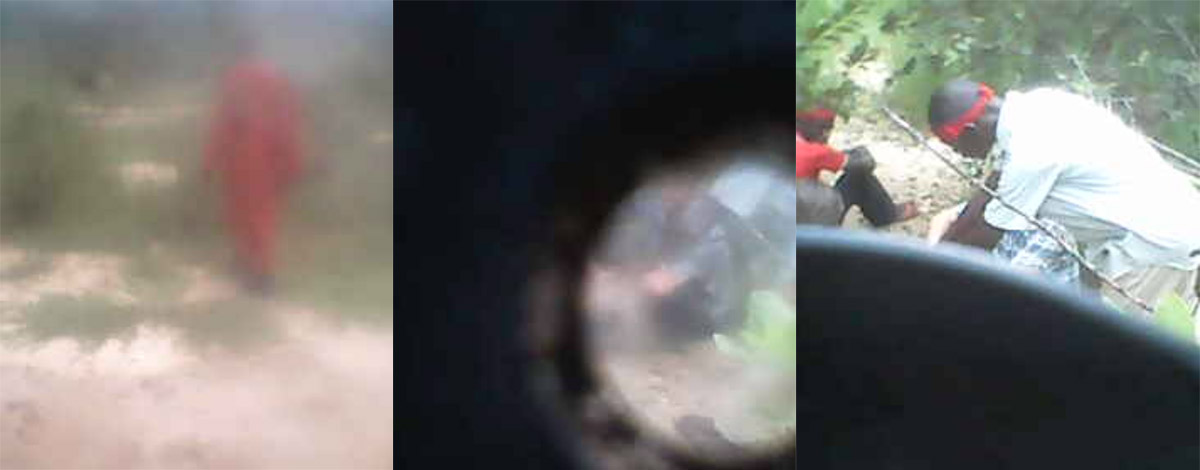
This video raises more questions than it provides answers. The alleged militiamen are a motley crew who do not seem to have the same level of information. When the first shot is fired, one of the alleged militia flees. This man, with a red band around his head and a black shirt, is one of those who had tried to reassure the experts by talking to them.
The second before the first execution, three of the assassins are heard discussing among themselves. The one filming is off camera. The other two are clearly identifiable, with red headbands and a scarf, but no apparent fetishes. The experts are seated and tense. They know the situation is serious, but there is no physical threat. Up until now, they have been walking freely. The alleged militiamen reassure them, telling them that all is well, that they will go to Tshiota, to see a chief. The American, Michael J Sharp, is worried about the number of firearms and knives in the groups’ hand, and asks them if they feel that they, the "UN people", have come to attack them.
"No, control yourself. Control yourself."
Excerpt of the video of the murder of the two UN experts, March 12, 2017.
A few seconds later, Michael J Sharp and Zaida Catalan are killed. It was an execution without any form of trial. After the event, the killers use some justifying words or ritual formulas specific to the Kamwina Nsapu, accusing the UN experts of having come to harm them or being “evil sorcerers". But the two individuals giving orders remain off camera. They sometimes mix Tshiluba, French, and Lingala, or Swahili. Yet, for the Kamwina Nsapu, these are the “languages of pigs”.
"Speak calmly to them, they might run away. Do not stress them. (...) Stop talking with gestures"
Main leader giving orders to the other killers, excerpt of the video of the murder of two UN experts, March 12, 2017.
The crime seems to have been planned not far, in Bunkonde, as the one filming says. It is difficult to know who or what he is talking about, but the main person giving orders explains that, in Bunkonde, one would have lied by saying that these weapons did not work. In the area where the experts were abducted, the main Tshiota, the "sacred fire", was in Ngombe, 24 km from Bunkonde. It was one of the most active Tshiotas in Dibaya Territory, and was founded after the death of Kamwina Nsapu. The followers of Kamwina Nsapu who fled repression came to settle in Ngombe, on the other side of the N40. Since this Tshiota was established, each village in the area has been "contaminated", creating its own militia. But at the time of the murder, there were no more active militias in Bunkonde. And for good reason: on March 12, the area was under the control of the Congolese army. Back-up had even arrived there on the previous Friday evening, on March 10, after fighting with militia groups in the vicinity. The Congolese military and the former militia were living side by side in Bunkonde.
The person filming also pronounces the words "Head of State” and even "rocket launcher,” but it is hard to say if these are literal meanings or nicknames. Just before the murder, he explains that “rocket launcher is already activated." He also desecrates the experts’ dead bodies, correcting himself when he gets mixed up between Swahili and Tshiluba. He remains off camera, but he is one of the main characters: he reassures the experts, removes the cover from his camera and orders their death. He fired a shot at each of them to make sure they were dead.
"Let them speak in Tshiluba. We are Baluba. Speak Tshiluba, sir"
Excerpt from a video showing the interrogation of captured policemen, attributed by the Congolese police to militiamen Kamwina Nsapu
Two more videos of abuses are blamed on Kamwina Nsapu militiamen. One of them also dates back to March. It was released by the Congolese police on the same day as the murder of the UN experts. Its intended purpose was to provide evidence of the presumed terrorist character of Kamwina Nsapu, an image the government has repeatedly put forth. The video depicts alleged militiamen capturing police officers and interrogating them in the middle of a village. According to the Congolese police, the police in the video were beheaded shortly thereafter. Tellingly, the police spokesman reports that every police officer except those who spoke the language of the militiamen—Tshiluba—were executed. The second video does not have a date, but it shows the results of an attack on a police station. In this video, the militiamen use one of the ritual formulas found in the video of the experts’ murder : "Let this land be yours"—a sentence that is believed to ward off bad luck. But this video differs in important ways from the experts’ execution video. There are not only men sporting brand new red headbands and armed with hunting rifles, like in the experts’ video. In this undated video, women and children are also seen, armed for the most part with wooden sticks and knives. Unlike the experts’ video, all of assailants state in exact terms what they blame their victims for. They do not hide it.
Attack of a police station by militiamen Kamwina Nsapu
Officially, the UN Secretary General, the United States and Sweden have opened an investigation. But three months after the death of the two experts, only MONUSCO via its police, UNPOL, has investigated on the ground in Kasai-Central. The families of Michael J Sharp and Zaida Catalan demand more. They want an independent inquiry—a "special inquiry"—ordered by the Security Council or, failing that, by the UN Secretary-General. At the time of the publication of this investigation, on June 13, the United Nations’ New York headquarters has so far limited itself to awaiting the results of a Board of Inquiry at the end of July. Yet the Board of Inquiry is tasked with evaluating internal UN procedures, and holds no explicit mandate to investigate the identity of the perpetrators of the experts’ deaths, the chain of command, or the causes behind their deaths.
The death of these two experts is undoubtedly one of the most symbolic events since December 19 ![]() . Since the appointment of the first group of experts in 1999, no expert has ever been injured. The assassinations of the two experts in March signal that one of the last taboos on the uses of violence in Congo has been transgressed. Independent experts are being killed in Congo. The Congolese government quickly completed its investigation - too quickly, says the UN - and has already begun a trial. For the rest, and for Kinshasa, no question of an international investigation has been raised—neither into the mass graves of the hundreds of civilians killed in the Kasais—nor into the deaths of Michael J Sharp and Zaida Catalan.
. Since the appointment of the first group of experts in 1999, no expert has ever been injured. The assassinations of the two experts in March signal that one of the last taboos on the uses of violence in Congo has been transgressed. Independent experts are being killed in Congo. The Congolese government quickly completed its investigation - too quickly, says the UN - and has already begun a trial. For the rest, and for Kinshasa, no question of an international investigation has been raised—neither into the mass graves of the hundreds of civilians killed in the Kasais—nor into the deaths of Michael J Sharp and Zaida Catalan.

haut de page





